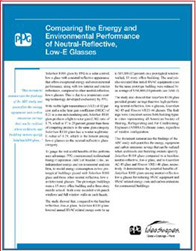PPG Industries (NYSE: PPG) has published "Comparing the Energy and Environmental Performance of Neutral-Reflective Low-E Glasses," a white paper that summarizes an energy modeling study of four commonly specified neutral-reflective, low-emissivity (low-e) glasses, including SOLARBAN(R) R100 glass by PPG.
The 24-page white paper, which is based on analysis performed by the Architectural Energy Corporation (AEC), compares modeled energy savings for neutral-reflective, low-e glass in two building types - a three-story middle school and a 15-story office building - in 12 North American cities.

The study showed that, when compared to the leading and next-best-performing neutral-reflective, low-e glass, Solarban R100 glass provided substantial energy and equipment savings over a building's lifetime, regardless of climate. In Miami, owners of a prototype window-walled, 15-story office building realized energy and equipment cost savings of more than $1.1 million, or almost $14 per square foot of glazing, during the building's 30-year life cycle. In Minneapolis, the 30-year life cycle savings totaled more than $650,000, or more than $7 per square foot of glazing area.
The study also highlighted the environmental advantages associated with specifying Solarban R100 glass. Because of its energy-saving characteristics, Solarban R100 glass diminished carbon emissions from the prototype office building by an average of more than 400 metric tons per year. During a typical 30-year building life cycle, such carbon emission reductions could total more than 12,000 metric tons, or the equivalent of removing nearly 2,000 passenger cars from the road over the same time period.
Solarban R100 glass is a neutral-reflective, solar control, low-e glass that is engineered by PPG to provide better solar control performance than competing products in the same architectural glass category. With visible light transmittance (VLT) of 42 percent and a solar heat gain coefficient (SHGC) of 0.23, Solarban R100 glass achieves a 1.79 light-to-solar gain (LSG) ratio that is up to 29 percent greater than that of competing neutral-reflective, low-e glasses.